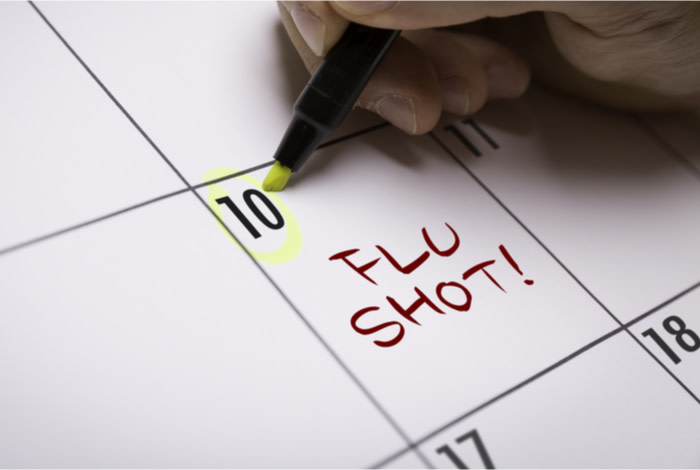
Let’s be clear. Although some people in positions of power have compared the coronavirus to the flu, it is not like influenza A or B, so getting a vaccine for this season’s flu strains is not going to do anything to combat the pandemic.
Interestingly, with the current social distancing & improved messaging around hand washing, the rates of influenza cases in Australia have diminished, but, the last thing anyone would want is to contract influenza & coronavirus around the same time. This would knock your immune system for a six.
Of course, that does not mean you should ignore getting the seasonal flu vaccine. If anything, making sure you are protected from this season’s flu strains is a great way to ensure that you’re healthy and can deal with both the coronavirus and the stress that social distancing and isolation is causing across the country.
Influenza, or the Flu, is a highly contagious respiratory virus that comes in three varieties, A, B and C. Influenza type A is the most dangerous and the only form of influenza to cause widespread outbreaks. While many people refer to a common cold as having “the flu”, influenza usually has more severe and pronounced symptoms.
Flu symptoms include:
- Fever
- Chills
- Headache
- Muscle and joint aches
- Fatigue and weakness
- Runny nose and sneezing
- Sore throat
- Cough
While Influenza viruses are always around, the flu usually has a greater impact during the colder months, so the flu season for Australia typically runs April/May through September, typically peaking around August.
While the two viruses may share a number of symptoms due to the fact that they are both respiratory viruses, there are a number of factors in which the two viruses differ, including:
- Speed of Transmission: Influenza has a shorter incubation period than COVID-19 - around 3 days compared to 5-6 days - meaning that Influenza can spread faster.
- Pre-Symptomatic Transmission: This means transmitting a virus when you aren’t showing any signs of having the virus. Pre-symptomatic transmission is a major driver of Influenza outbreaks but at the moment it does not seem to be the case for COVID-19.
- Infection Carriers: Children are one of the major drivers of Influenza infection, whereas adults seem to be the major drivers of infection with COVID-19.
- At Risk Age Groups: Children, pregnant women, the elderly, those with underlying chronic medical conditions and those who are immunosuppressed are most at risk of severe illness with Influenza. The elderly and those with underlying medical conditions appear from current data to be more at risk of serious COVID-19 infection.
- Mortality: COVID-19 appears from available data to have a mortality rate of around 3% (this will most likely lower as more data become available), whereas seasonal Influenza has a mortality rate around 0.1%.
Influenza and Vaccination
Is the Vaccine Safe and Effective?
The short answer is yes with a few small caveats. In Australia, all flu vaccinations are “inactivated”, meaning that they have no live flu virus in them. Although people may claim that vaccines “shed” viruses or that the vaccine can give you the flu, this is impossible.
Some people may experience flu-like symptoms for a short while (usually a maximum around 48 hours) after getting a flu vaccine, but that doesn’t mean that the vaccine gave them the flu. The cause of these symptoms is the vaccine triggering the type of immune system response it is intended to trigger.
No vaccine is 100% effective, and that is true of the yearly flu vaccine. Studies have shown that the effectiveness of a flu vaccination ranges from about 30%-60%, meaning that anyone immunised is 30%-60% less likely to contract influenza during the season. While this may seem like a rather small number, Influenza can potentially be very dangerous, so lowering the risk of infection is definitely worth the jab.
The Influenza vaccine is grown in eggs, but the Australasian Society of Clinical Immunology and Allergy (ASCIA) states that the amount of egg protein present in the vaccine is so minimal it poses a statistically insignificant risk to those with egg allergies, or around 1.35 cases per 1 million doses.
Is there Anything Else I Can Do to Protect Myself from Influenza?
If you’re already staying home, social distancing and observing proper hand hygiene due to the COVID-19 pandemic then you’re doing all you can to protect yourself against the flu.
How Much Does It Cost?
For a number of Australian groups, getting a flu shot is free thanks to the federal government National Immunisation Program (NIP) . If you all into any of the following groups or categories you can get the jab at no cost:
- All Aboriginal and Torres Strait Islander people over the age of 6 months
- All Children between 6 months and 5 years old
- Everyone 5 years and over that is considered to be at risk due to medical conditions, including cardiac diseases, chronic respiratory conditions, diabetes mellitus, chronic metabolic diseases, chronic renal failure, multiple sclerosis, spinal cord injuries, HIV and cancer. Check with your GP or primary care physician to see if you qualify.
- Pregnant women - the vaccine is safe during pregnancy and can be given at any stage.
- People aged 65 and over. The Flaud Quad vaccine is designed specifically to produce a higher immune response in this age group.
For those not able to get a free vaccination, prices vary depending on the GP or pharmacy administering the vaccination but prices usually fall between $15 and $25 or so.
If you want to book an appointment to get a flu vaccination then the easiest way to find a GP is through MyHealth1st.
If you’d prefer to get your vaccine from a pharmacy , check the website for your local chemist to see if they offer vaccinations and if they take bookings online.